Maqluba ~ The National Dish of Palestine
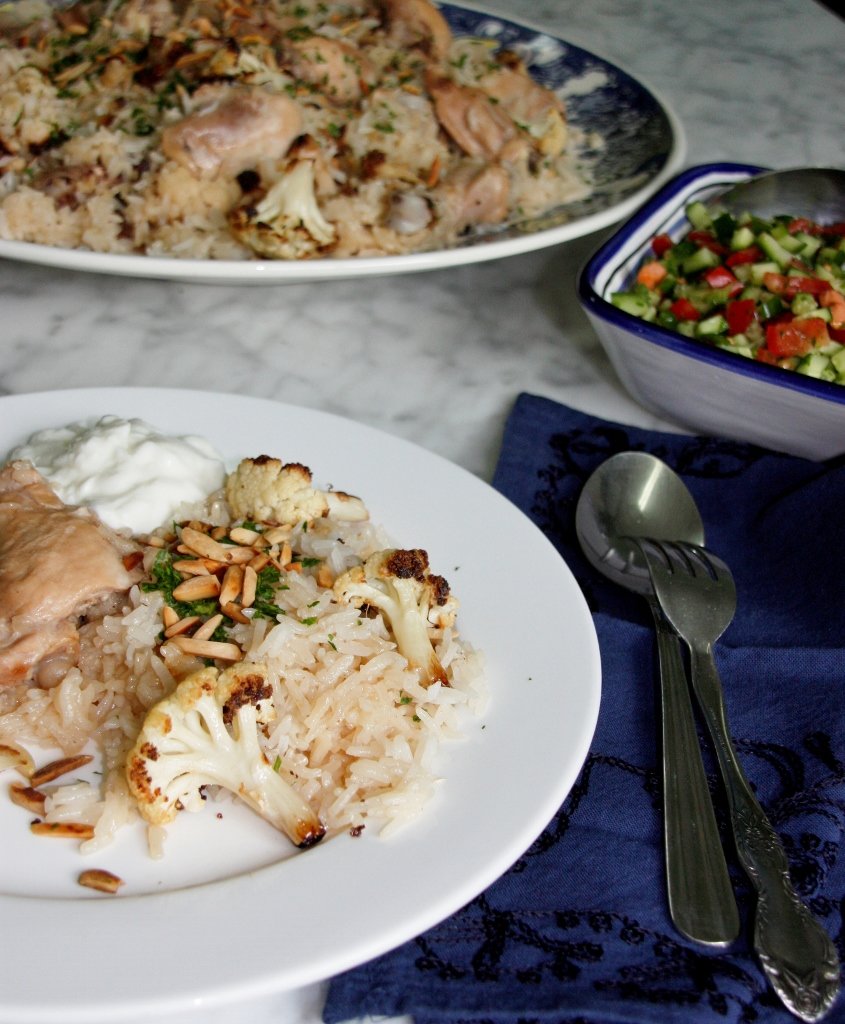 Every Palestinian family has their own way of preparing Maqluba, which means “upside-down” in Arabic. This main dish has countless variations in ingredients, measurements and technique. The basic method is this: a large cooking pot is layered with meat or chicken, vegetables and rice; it’s cooked on the stove and flipped upside-down onto a large platter and served with yogurt on the side.
Every Palestinian family has their own way of preparing Maqluba, which means “upside-down” in Arabic. This main dish has countless variations in ingredients, measurements and technique. The basic method is this: a large cooking pot is layered with meat or chicken, vegetables and rice; it’s cooked on the stove and flipped upside-down onto a large platter and served with yogurt on the side.
I first learned to make Maqluba from my Palestinian mother-in-law, but I have gradually adjusted the dish over the years. At our home, Maqluba is always made with chicken and cauliflower. Others prefer lamb or eggplant. The vegetables are traditionally fried. However, I prefer to brown the cauliflower in the oven. Any chicken pieces can be used, but I have found that thigh and leg pieces cook evenly and serve up nicely. Below is my recipe:
Maqluba
Serves 6-8
Ingredients
1 large head of cauliflower, cut in flowerets, washed and dried well
¼ cup + 2 T canola oil
1 large white onion, chopped
Chicken pieces, approx 15 legs & thighs, skin removed and cleaned
3 cups long-grain rice
Salt to taste
Parsley, finely chopped (optional garnish)
Almond slivers, toasted (optional garnish)
Yogurt, served on the side
Method
- Begin by browning the cauliflower. Drizzle some of the ¼ cup oil onto a large baking sheet. Toss the cauliflower with the remaining oil to coat evenly. Spread cauliflower on the baking sheet in a single layer.

- Bake cauliflower in a pre-heated hot oven, 400 F/200 C (gas mark 6) for 10 -12 minutes until golden brown on the bottom. Turn and bake for another 10-12 minutes. Drain on paper towel. Salt lightly.

- In a large cooking pot, heat the 2 T oil over medium heat. Add onion and sauté for 5 minutes until translucent. Add chicken pieces and cook over medium-high heat for 5-8 minutes, turning once or twice. The chicken pieces will be browned slightly and partially cooked.
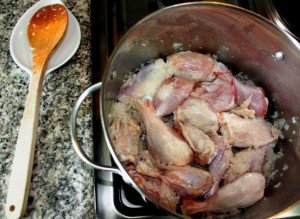
- Cover chicken with water, approximately 6 cups. Bring to boil. Lower heat and cover. Simmer for 12 minutes (longer if using larger pieces). Skim off any foam from the top.
- Meanwhile, soak the rice: place rice in a bowl, cover with boiling water and stir. Let sit for 10 minutes, drain well and set aside.
- When chicken is finished, remove pot from heat. With a slotted spoon, remove chicken pieces and set aside. Remove liquid from the pot and reserve 5 cups. (Discard any excess.) Season the liquid with 1½ teaspoons salt or to taste.
- Assemble the dish. In the empty pot, layer the bottom with cooked chicken pieces. Next, add a layer of cauliflower. Top with the soaked rice. Smooth the top. Add the 5 cups of salted liquid. To avoid disturbing the layers, place a small saucer on the rice and pour over it. Remove saucer and smooth the top again.
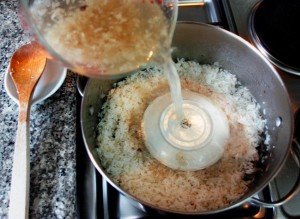 8. Bring to a gentle boil. Cover and simmer over low heat for 20 minutes. Check for doneness with the end of a wooden spoon nudged to the bottom of the pot. If any liquid remains, cook for another few minutes until all liquid is absorbed.
8. Bring to a gentle boil. Cover and simmer over low heat for 20 minutes. Check for doneness with the end of a wooden spoon nudged to the bottom of the pot. If any liquid remains, cook for another few minutes until all liquid is absorbed.
9. Remove pot from heat and let rest for 5 minutes. Invert pot onto a large platter, flipping upside down. Remove pot and scoop out any remaining food.
10. To serve: fluff the rice and arrange the chicken pieces on top. Garnish with chopped parsley and toasted almonds. Maqluba should be served with yogurt or a yogurt-based salad. It may also be served with a simple Arabic salad of cucumber, tomatoes, parsley, lemon juice and salt.
Share your experiences with Maqluba.
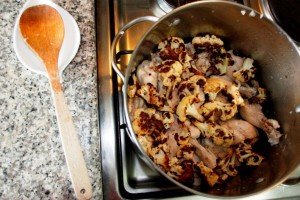
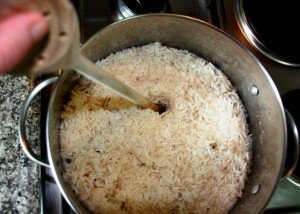

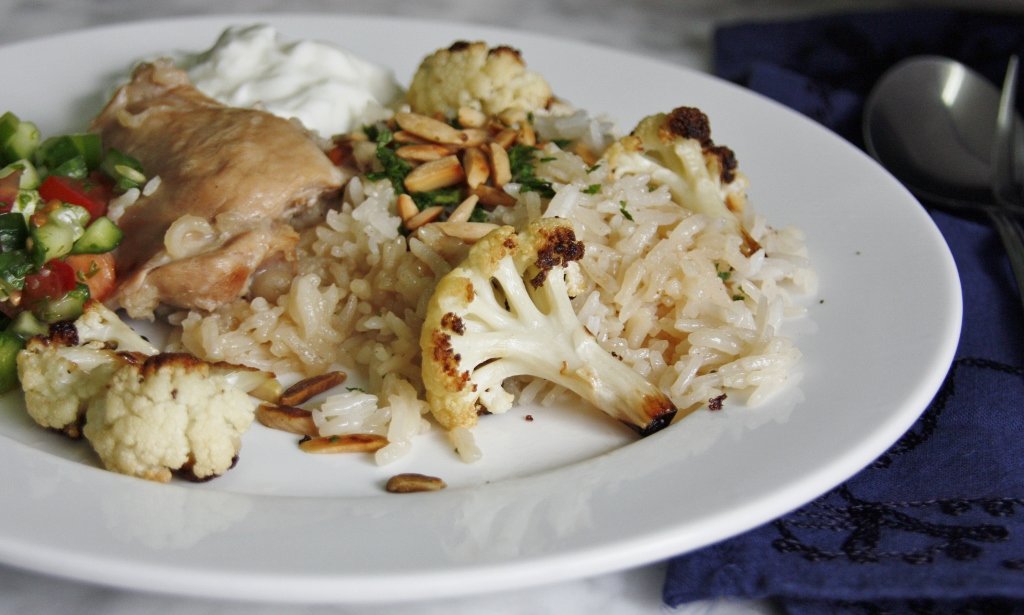
 Follow
Follow
MMMMM, looks yummy! Thanks for the recipe, Holly!
Showed my husband this post and he wants me to make it for dinner. Just a couple of questions:
1) can I use non stick pans or it has to be steel?
2) can I use olive oil instead of canola?
3) can I use pine nuts instead of almonds?
My mother in law will be here in a week, I might get her to make it instead! LOL.
I need to make this… I wish it wasn’t 10pm so I could make it tonight!! Yummmm!!
@Busy Mommy
Thanks for reading. Yes, to all of those questions! I have seen it made all of those ways. This is a flexible dish. You can even add spices if you prefer a bit more flavor — tumeric, saffron, curry, cumin… Enjoy.
Food looks so good- and easy enough to actually try!
I made this tonight and it was very nice. I like the simplicity of the flavor, the salad was a must for us. We also had it with pita bread which really pulled it together. Have you cooked it w/ a tortilla at the bottom of the pot so that when the water evaporates you get a crispy tortilla on bottom/top when you flip it over? A family friend always cooks Arabic rice this way and it’s awesome! Think I’ll try that next time. Keep the recipes coming please! In the spirit of Ramadan we are trying at least 3 Arabic recipes a week. 🙂
@Busy Mommy Thanks for the comment. No, I haven’t tried the tortilla on the bottom. However, There are some Arabic rice & meat dishes that require a very thin bread as the bottom layer which soaks up all the juices. Very yummy. I’m glad you enjoyed the recipe. I have new one coming soon… Take care & Happy Ramadan!
As salamu ‘aleyki
Shukran for the recipe. I’am just about finished making this and made a few changes as I went along (just because I enjoy playing around with the variety of spices and didn’t have cauliflower at hand). I roasted broccoli instead and rubbed the chicken pieces in the following homemade spice mix: ginger, crushed garlic, roasted garlic, toasted cumin and coriander, paprika, mild chilli (just for taste), lil bit of curry and a mix of italian herbs (no msg) and some salt. It was frying nicely together and gave the entire home a nice warm smell of the various spices. I poured boiling stock over the chicken to keep everything still cooking and to enhance a lil. On the side I made a polish salad of diced tomatoes, cucumber with some sour cream, salt n pepper. I just can’t wait now to taste it.
@naima leonard Sounds delicious! I like the changes you’ve made. I’ve heard of this dish being made with other veggies: carrots, potatoes or eggplant. I’ve seen it with various spices such as turmeric or curry. Your version sounds extra-flavorful and healthy. Thanks for the comment.
I first ate this dish in my Palestinian friend’s house. It was amazing! She cooked it with cauliflowers and chicken as you did.
Thank you for the recipe and the traditional tips. I will try it this weekend 🙂
@Ayse So glad you found the recipe! I hope it works well for you. Thanks for stopping by & leaving a comment. 🙂
As salam u Alaikum,
I’m Palestinian American and this has always been my favorite food. Everyone has their own way of doing Maqluba. Growing up my mother would make it the traditional way which is by frying eggplant, potatoes, and cauliflower. We always do it with chicken most people love it with chicken rather than lamb. My mother in law includes carrots in her maqluba and I started doing the same. I made it the other day and I only had potatoes and it turned out delicious. I love using spices and the main spice that I use in mine is Allspice, I put a lot in it too and also a lot of black pepper (I like my maqluba on the spicy side). I noticed you didn’t add the vermicelli noodles, almost all middle easterners put vermicelli in their rice. We brown it or fry it and make sure it doesn’t get dark, we strain the oil off and then we mix it in the rice and the spices. I don’t think it will matter if you have it or not because it doesn’t really change the flavor just more of a visual look I guess. Thank you Holly for sharing your recipe.
@Reba Thank you, Reba, for stopping by and commenting. Yes, I love all the variety of maqluba. Have never tried it with vermicelli though. I add it to rice pilaf just the way you describe. Thanks again for reading & giving your thoughts!!
I’m going to try this recipe this week hopefully. =) Thanks for posting! I’ve had it at my mother in law’s house but don’t remember which veggies she used… I only have carrots and spinach right now though so I think I’ll replace the cauliflower with carrots and test it on my hubby. =)
Good luck, Amanda. Tell me how it goes!
I just made it last night actually, and my hubby loved it yay =D I used carrots, and added ginger, garlic, paprika, and cumin, it turned out yummy. =) Thanks so much for the easy recipe!
Thank you, Holly. This is a wonderfully easy recipe that works perfectly, even though I tend to cook by eye rather than measuring ingredients. It was just like the maqluba I had in Palestine some 18 years ago and I have added it to my recipe scrapbook and Linked to it on Twitter. There’s lots of scope for tweaking according to what you have in the kitchen, too. Divine!
Helen, I’m sooo happy the recipe worked out for you and it tasted like the real deal. I really appreciate your comment. Happy Cooking! 🙂
Shukran Reba! My husband is from Palestine and I am cooking Maqluba for his birthday, today. I was looking for a recipe that has all of the ingredients he purchased and yours (Holly) was close, but didn’t include the vermicelli or tomatoes. I had no clue what to do w/ the vermicelli and the label is in Arabic.
Hi Janna, I don’t think I’ve seen maqluba with vermicelli. However, there are many Arabic rice dishes that use vermicelli. For a rice pilaf, you gently pan-fry some vermicelli noodles (say, 1/2 cup). When they are golden brown, cook them with the rice (often with chicken stock & some seasonings). You would need a bit of extra water in the pot for the vermicelli. As for Maqluba, not sure how to add vermicelli to that dish. Really, the vermicelli noodles are an accent item; they are not going to change the dish dramatically whether you add them or not.
As for the tomatoes, I would make a tomato-cucumber-parsley salad & serve on the side with the maqluba. Also, some plain yogurt goes well.
I hope this has helped you & my reply is not too late. Happy cooking & all the best to you!
Do you fry the potatoes as well?
Hi Janna, Yes, I would gently pan-fry or roast the potatoes. But don’t overdo them because they will cook again in the pot with the rice. If the potaotes fall apart, don’t dispair. You’ll get it right the next time. I find that Arabic cooking is one big experiment. 🙂
Thank you so much Holly! It came out perfect and my husband ended up taking over mostly lol. The dish came out perfect! I will definitely be making it more often. I have made Mulukia, Kinaffle, Chicken Shawarma, humus, Basmati rice, and Bakliva. We have a 12w old daughter and I try to embrace as much of the culture b/c I am w/ her all of the time. I watch the Arabic channel (I love the soaps lol). I have Rosetta Stone, but the dialect is not from his region. it’s more of a basic type. I would love to swap recipes! Thanks again for helping me make my husband’s birthday extra special.
Hi Janna, I’m so glad it turnd out! Thank you for sharing this with me. Yes, I agree. Food is a wonderful way to share culture. Learning a foreign language is much more difficult. I hope to do a post eventually about good books for learning Arabic. Thanks again & salaam!
Oh and the tomato burned anyway, but we did have the cucumber, tomato, onion, parsley salad w/ lemon juice and salt, that my husband makes. I wanted to make the Grecian sauce: yogurt, garlic and minced cucumber, but I forgot to get the yogurt. The vermicelli is like a garnish. My husband said it’s to make it look pretty
Oh, the vermicelli is like a garnish… hmmm…. very interesting. So many variations to Arabic cooking! I like to add toasted almonds if I have guests. Thank you for reading & commenting on my blog, Janna. 🙂
This recipe needs some additional flavor. Traditional Palestinian Maklubeh is made with allspice and cinnamon or nutmeg. Serve it up with some Tubulleh 🙂
Hi Holly, Sounds delicious! Actually, I love maqluba with curry!! Tastes so good with the yogurt…. alas, my husband’s family & my children prefer “white” maqluba. I think it’s a regional thing–or maybe it’s just my husband’s clan. That’s the thing with Palestinian cooking, even though it’s a small country, what is “traditional” varies from city to city, village to village, family to family…. Have never had maqluba with tabulleh, but why not?! You’ve given me some ideas. Thanks for stopping by and for the comment.
I think its great that people are prepared to try cuisines from other cultures, its something I love to do and love to cook. Im glad i discovered your blog 🙂
Hi Beverly, Thanks so much for stopping by & for the comment.
Hi Holly — so delighted that while surfing for a good maqluba recipe I stumbled on your site! Thanks so much for this recipe, I can’t wait to try it. 🙂
Zoë
Hi Zoe,
Thanks for stopping by & reading!
I hope the recipe worked out for you.
All the best, Holly
Thanks for the recipie it sounds lovely.
I’m actually doing a skwl project on Arabic cuisine and I’m using yr recipie as the main, hpe u don’t mind!
U should try out Baba Ganoush _ type of salad
HI Tazzy,
Feel free! I hope it works out for you.
I LOVE baba ganoush (& mutabal which is another eggplant salad).
Thanks for the idea & thank you for reading! Holly
Hi Holly, I really love your website and thanks for showing us this recipe. I want to try it but should I cut all ingredients into half if it only serves 2 people ?
Also instead of long grain rice, can I use Indian basmati rice ? I just bought 5 kilo at home.
Thank you.
Celmah
HI Celmah,
Sorry for my slow reply!
Yes, you can halve the recipe & use a smaller pot.
Basmati rice works perfectly.
Thanks for reading!
Holly
Hi Holly, Both my parents are Palestinian, I was born & raised in Jordan and have grown up with my grandmothers Malube recipe. I enjoy your recipes and your take on this dish. Malube has always been my favorite dish and is now my easy go to weekly staple at my house since its also my sons favorite. We have always made it with Allspice, nutmeg cinnamon with a touch of coriander and use both cauliflower and eggplants- and serve it with plain yoghurt- the traditional way- but I never added toasted almonds for garnish until last night after coming across your recipe and I must admit it made my dad smile saying that it was how his own grandmother presented the dish. Apparently His mom (my grandma) revised her recipe since she didnt tolerate nuts. People here make it with slight variations in flavor and its delicious no matter what : )
Talia, Thank you so much for your lovely comment and for sharing your family experiences here. There are so many ways to make this dish. (In my husband’s family they have actual arguments over whether or not to add spices.) Reading your comment makes me hungry for maqluba! Thanks again, Holly
Ladies I have made this dish 100 times as my husband is Palestinian, this recipe needs more spices. You can add salt pepper onion powder season all Sazon while you are boiling the chicken and add all spice or 5 spice. Also if you fry potatoes and eggplant with it it will make it even more delish. Olive will also give it a great taste 🙂 good luck ladies
Thanks, Yani! Yes, there are so many variations to this dish. Some people love it with lots of seasonings, whiles others like it more plain. Personally, I prefer it with curry! But husband and children like it “white” so that’s how I prepare it.
A favorite dish in our family..
I just watched the Anthony Bourdain Parts Unknown show on Jerusalem where he was treated to a feast of Maqluba. The people cooking the dish used the combination of cinnamon, nutmeg and cardimon but I have no clue as to how much of each spice. Can you give me some idea as your recipe is the only one that has my interest, but we do love spices. Also, when they were making their rice it looked as though they had added chick peas, and the rice seemed to take on a yellow color … do with think it’s saffron?
HI Jackie,
Thank you for the comment. I am going to have to track down that episode!
First of all, there are many many variations to this dish. There are people who make “white maqluba” without spices (like my recipe) and there are others who insist to have spices. Believe it or not, this difference has been known to cause family arguments!
I would just experiment with adding 1/2 t cinnamon, 1/4 t nutmeg & 1/4 cardamom. If that is not enough spice, work up.
When the rice is cooked, it’s cooked with onion, and chicken (or lamb) & vegetables (often cauliflower). This can give a texture to the rice. Bits of cauliflower & bits of onion may look like the chickpeas. I haven’t heard of chickpeas in maqluba, but it wouldn’t surprise me!
Thanks for reading and stopping by. I will look for that Jerusalem episode. Holly
Hi Holly,
Thank you for this recipe. Let me forward it to my fiancee 🙂
Hi Jithin, Thank you for stopping by! I hope you try this dish. 🙂
My son just returned from serving 2 years in the Peace Corps in Jordan and this was his first request. We will be making this tomorrow. Thanks for the recipe and illustrated directions.
HI Wayne, Thanks for stopping by and for the comment. That’s wonderful that your son served in the Peace Corps in Jordan for 2 years. I hope he had a good experience & I hope you enjoyed the recipe. All the best, Holly
This excellent website really has all of the information and facts
I wanted about this subject and didn’t know who to ask.
If some one desires to be updated with hottest technologies after that
he must be pay a quick visit this web page and be up to date daily.
hi!,I really like your writing very so much!
proportion we be in contact extra approximately your post on AOL?
I need a specialist on this house to unravel my problem.
Maybe that is you! Having a look ahead to look you.
Thanks for all the ideas. I am enjoying watching and reading palestinian recipes and learn more about it as I want to surprise my husband (who is a Palestinian) with my cooking being newly wed. Hope he will like the food everytime I cook for him. Insha allah! 🙂
HI Mary, Thanks for reading & commenting. All the best to you & happy cooking!